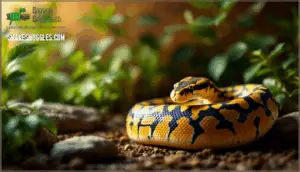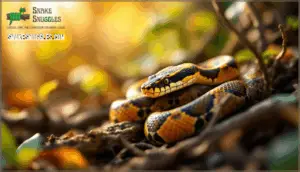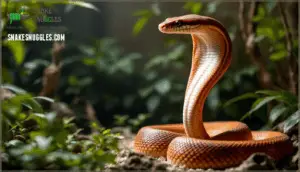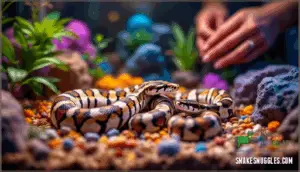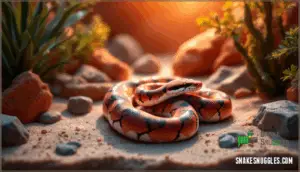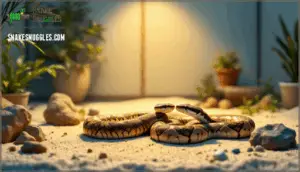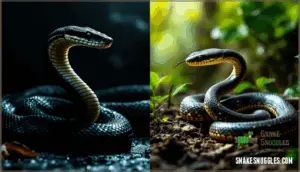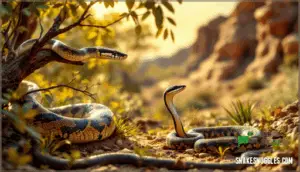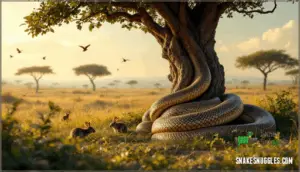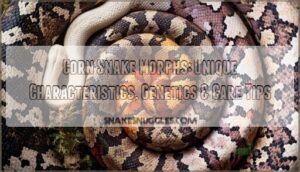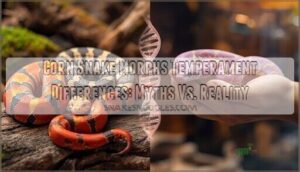This site is supported by our readers. We may earn a commission, at no cost to you, if you purchase through links.
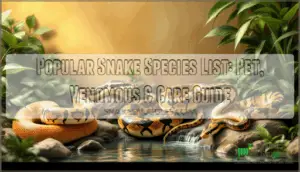
But the snake world extends far beyond beginner-friendly constrictors. From the neurotoxic bite of a coral snake to the striking patterns of kingsnakes that mimic their venomous cousins, understanding popular snake species means recognizing which ones belong in your living room and which demand respect from a distance.
Whether you’re drawn to compact rosy boas or intimidated by eight-foot red-tailed boas, knowing the differences in size, temperament, and care requirements transforms curiosity into confident ownership.
Table Of Contents
Key Takeaways
- Ball pythons dominate the pet trade because they forgive beginner mistakes in temperature, humidity, and handling—making them the ideal gateway species for new reptile keepers who need resilience over perfection.
- Distinguishing venomous from non-venomous snakes requires checking head shape, pupil type, and scale patterns, not just color bands—kingsnakes and milk snakes deliberately mimic dangerous coral snakes to fool predators.
- Snake size directly impacts your long-term commitment, with compact rosy boas maxing out at 3 feet versus red-tailed boas hitting 10 feet, requiring vastly different enclosure space, feeding costs, and handling confidence.
- Snakes control rodent populations and stabilize food webs across ecosystems, but habitat loss and illegal wildlife trade now threaten over 21% of reptile species globally, pushing conservation efforts to critical priority.
Most Popular Pet Snake Species
If you’re thinking about getting a pet snake, you’ve got some solid options to choose from. The species below represent the most popular picks among keepers—and for good reason.
Each one brings something different to the table, whether you’re after something docile, colorful, or just plain manageable.
Ball Pythons – The Top Choice
If you’re looking for a snake that won’t give you headaches, ball pythons are where it’s at—they’re basically the benchmark for anyone thinking about bringing a scaled friend home. These docile constrictors dominate pet snake communities thanks to their manageable temperament and straightforward care.
Ball python genetics offer endless morphs, making them irresistible to breeders. They’re legal in most places and thrive in captivity with minimal fuss.
Python regius demands aren’t steep: proper enclosures, consistent feeding, and occasional interaction keep them thriving for 15–20 years.
Corn Snakes – Colorful and Adaptable
Where ball pythons play it safe, corn snakes are the adventurers of the pet world—they’ve got the colors, the attitude, and the adaptability to thrive just about anywhere you set them up. Pantherophis guttatus ranks second globally among pet snakes for good reason:
- Corn snake morphs showcase striking snake color genetics—amels, tesseras, and bloodreds keep captive breeding exciting
- Adaptive behaviors let them manage varied temperatures better than most species
- Snake nutrition needs are simple: frozen rodents every 5–7 days
- Pet snake care stays budget-friendly with affordable setups
- They live 15–20 years, giving you decades of companionship
You won’t find a more forgiving species for beginners.
Red-Tailed Boas – Impressive Size
Corn snakes keep it manageable, but red-tailed boas (Boa constrictor) bring the wow factor—these snakes grow to 10 feet and command respect without demanding expert-level care.
You’re getting into constrictor territory here, where boa enclosure size matters and managing large boas requires confidence. Their boa temperament stays remarkably calm, and red-tail morphs—from hypermelanistic to albino—let you customize your collection.
Boa constrictor size makes them statement pet snakes, not starter species.
Kingsnakes and Milk Snakes – Beginner-Friendly Options
If boas feel like too much commitment, kingsnakes and milk snakes deliver the color variety without the size—these snakes max out around 3 to 5 feet and stay docile enough for first-time keepers.
Both species thrive on straightforward pet snake nutrition—frozen mice every 7-10 days—and rank among popular snake species for beginners who want snakes as pets without sacrificing visual impact.
- Kingsnake behavior leans bold and curious, making snake interaction tips easy to master—they rarely refuse meals and tolerate beginner care mistakes.
- Milk snake morphs range from classic tri-color bands to tangerine and ghost variations, rivaling corn snakes for pattern diversity.
- Both species thrive on straightforward pet snake nutrition—frozen mice every 7-10 days—and rank among popular snake species for beginners who want snakes as pets without sacrificing visual impact.
Rosy Boas – Small and Striking
Rosy boas pack serious visual punch into a compact 2- to 3-foot frame, making them the go-to choice when you want striking patterns without wrestling a giant snake during cage maintenance. Boa color morphs range from desert oranges to coastal grays, giving reptile owners palette options rivaling corn snakes.
Small snake enclosures—a 20-gallon tank accommodates adults—and simple boa feeding tips (one appropriately sized mouse every 10-14 days) make rosy boa care beginner-proof for pet snakes enthusiasts mastering snake management techniques.
Western Hognose and Kenyan Sand Boas – Rising Favorites
Western hognose snakes and Kenyan sand boas are climbing the popularity ladder fast, thanks to their quirky personalities and pint-sized care requirements that won’t hijack your living room.
Hognose care involves minimal sand boa habitat setup—a 10- to 20-gallon enclosure accommodates adults—while boa feeding stays simple with appropriately sized rodents every week.
Snake management grows easier as these pet boas tolerate interaction well, making reptile ownership accessible for newcomers exploring diverse snake species beyond mainstream picks.
Venomous Vs. Non-Venomous Snake Species
Not all snakes bite with venom—some constrict, some bluff, and some are just misunderstood. Knowing the difference between venomous and harmless species can keep you safe in the wild and confident as a snake owner.
Let’s break down the key players you need to recognize.
Common Venomous Snakes in The U.S
You’ll find four major venomous snakes across North America: rattlesnakes, copperheads, cottonmouths, and coral snakes. Copperhead encounters lead all venomous snake species with nearly 3,000 bites annually, while rattlesnake bites pack up to four times more potent venom. Understanding pit viper attacks and proper snake species identification can save your life in the wild. For more information on snake bites, visit the snake bite statistics to learn about venomous species and their habitats.
| Snake Species | Bite Frequency | Geographic Hotspot |
|---|---|---|
| Copperhead Snake | ~3,000 bites/year | Southeastern U.S. |
| Rattlesnakes | Most fatal (5/year) | Arizona (14 species) |
| Cottonmouths | Significant portion | Wetlands/Southern states |
| Coral Snake | <1% of bites | North Carolina (endangered) |
| All Pit Vipers | 98% of U.S. bites | North Carolina (157.8/million) |
North Carolina reports the highest venomous snakebite rate at 157.8 per million—five times the national average. Snake venom varies dramatically: coral snakes deliver neurotoxic venom, while pit vipers cause severe tissue damage. Venomous snake safety starts with recognizing patterns and habitats where these species thrive.
Non-Venomous Snakes Popular as Pets
Most pet lovers don’t realize that the safest, most beginner-friendly snakes are actually the non-venomous species bred specifically for captivity. Pet snake breeding has refined corn snakes, ball pythons, and kingsnakes into docile companions perfect for mastering snake management tips and pet snake nutrition.
These snakes thrive with basic attention, offering a pure reptilian connection without the risk of venom.
| Species | Why They’re Perfect |
|---|---|
| Corn Snakes | Affordable, colorful, easy snake care |
| Ball Pythons | Calm temperament, minimal snake habitat design needs |
| Kingsnakes | Hardy nonvenomous snakes, beginner-proof |
| Garter Snakes | Active, small, low-maintenance pet snake care and maintenance |
These non-venomous species are ideal for beginners, providing a safe and rewarding introduction to snake ownership.
Snake Mimicry and Identification Tips
Harmless kingsnakes and milk snakes trick predators by copying coral snake color patterns—red, yellow, and black bands that scream danger. This mimicry evolution makes snake identification tricky, especially since some regions show 2–6 times more mimic species than actual venomous snakes. You’ll need to check head shape, pupils, and scale patterns for accurate species recognition beyond just color morphs.
Understanding the mimicry types is essential for distinguishing between venomous and nonvenomous species.
| Feature | Venomous Models | Nonvenomous Mimics |
|---|---|---|
| Head Shape | Triangular, distinct neck | Narrow, rounded |
| Pupil Type | Vertical slits | Round pupils |
| Pattern Order | Red-yellow-black bands | Red-black-yellow bands (often) |
| Snake Behavior | Defensive, may rattle | Docile, rarely aggressive |
Understanding mimicry patterns helps you distinguish dangerous species from harmless look-alikes in the wild.
Snake Size, Lifespan, and Care Needs
Choosing the right snake means understanding what you’re signing up for. Size, lifespan, and daily care vary wildly between species, and knowing these details upfront keeps you from biting off more than you can chew.
Here’s what you need to know to match your lifestyle with the snake that fits it.
Typical Size Ranges for Popular Species
When you’re shopping for your first snake or adding to your collection, size matters more than you might think—it affects everything from tank dimensions to feeding costs to how easily you can manage your new companion. Here’s what you need to know about snake length and species growth for popular pet snakes:
- Ball pythons usually reach 3-5 feet, with average weight around 3-5 pounds—perfect for apartment living.
- Corn snakes stay manageable at 4-5 feet, making snake care straightforward for beginners.
- Red-tailed boas can hit 8-10 feet, requiring serious space and commitment.
- Kingsnakes range from 3-6 feet depending on subspecies—size variations matter when snake breeding and keeping.
- Rosy boas max out around 3-4 feet, ideal for managing and smaller setups.
Understanding snake species and characteristics helps you match pet size to your lifestyle.
Expected Lifespans in Captivity
Captive snake longevity blows wild lifespans out of the water—your pet snakes can become decades-long companions with proper reptile care. Ball pythons average 20 years but can hit 50 with superior snake care tips. Corn snakes reach 15-23 years, with record-holders hitting 32. Red-tailed boas live 20-30 years, occasionally surpassing 40. Kingsnakes and milk snakes usually last 15-20 years, while rosy boas can exceed 30.
Snake breeding and keeping practices directly impact reptile life expectancy and captivity survival rates.
Enclosure and Environmental Requirements
Your snake’s home needs to mirror its natural habitat—get the enclosure specs wrong, and you’re cutting years off that impressive lifespan.
Snake habitat mastery demands precision with these reptile care fundamentals:
- Temperature control: Heat gradients between 75-95°F depending on species
- Humidity levels: 40-80% range using proper substrate options
- Ventilation systems: Adequate airflow prevents respiratory infections
- Lighting requirements: UVB optional for most, but day/night cycles essential
Master these snake care basics, and you’ll transform captivity into thriving reptile conservation success.
Feeding, Handling, and Health Maintenance
Once the enclosure is dialed in, feeding protocols and care techniques separate thriving snakes from those barely surviving. Snake nutrition mastery starts with proper feeding schedules—most adults eat every 7-14 days. Frozen-thawed prey is preferable to live prey for safety reasons.
Care techniques that build trust are essential. Confident, slow movements during regular handling sessions help reveal snake behavior and ecology patterns.
| Health Maintenance Task | Frequency |
|---|---|
| Visual health checks | Weekly |
| Deep habitat maintenance | Monthly |
| Veterinary wellness exam | Annually |
| Shed cycle monitoring | Every 4-8 weeks |
Watch for signs of respiratory distress, refusal to feed, or abnormal snake behavior, as these indicate that your pet snakes require immediate attention.
Global Snake Diversity and Distribution
Snakes have conquered nearly every corner of the planet, from steamy rainforests to scorching deserts. Over 3,500 species exist worldwide, each shaped by the unique demands of their environment.
Let’s explore where you’ll find the greatest diversity, the habitats snakes call home, and the extraordinary adaptations that let them thrive anywhere.
Snake Species Richness by Country
Snake species diversity across countries reveals fascinating geographic patterns, with Mexico topping the list at 438 documented species—a true biodiversity hotspot. You’ll find impressive reptile diversity in North America, particularly in the United States with 178 species, while Brazil claims over 400, showcasing remarkable species distribution in South America.
- Mexico leads country rankings with the highest snake species variety globally
- Brazil dominates biodiversity hotspots with outstanding species diversity in rainforest regions
- The U.S. shows significant reptile diversity with Florida counties reporting 30-63 species each
Understanding these geographic patterns helps with wildlife and conservation efforts, especially as global trade moves millions of live snakes annually. The conservation status of many species depends on protecting these biodiversity-rich regions.
Snake Habitats: Rainforests, Deserts, and More
From lush tropical canopies to scorching desert sands, snakes have mastered nearly every habitat on Earth except Antarctica. Rainforest ecosystems harbor the greatest snake species diversity, while desert adaptations enable survival in harsh conditions. These reptiles thrive in aquatic habitats, terrestrial environments, and arboreal homes, each playing a crucial ecological role in wildlife and ecosystems.
| Habitat Type | Notable Species |
|---|---|
| Rainforests | Anacondas, Emerald Tree Boas |
| Deserts | Sidewinders, Sand Boas |
| Aquatic | Cottonmouths, Water Snakes |
Reptile conservation depends on protecting this extraordinary habitat diversity.
Snake Adaptations to Different Environments
Evolution didn’t just place snakes in different habitats—it transformed their bodies into precision tools for survival. Desert survival means heat-resistant scales and sidewinding locomotion across sand. Rainforest adaptation brings prehensile tails for arboreal climbing and camouflage patterns. Aquatic abilities include flattened tails for swimming and specialized breathing adaptations.
Environmental resilience defines snake adaptations, maintaining ecosystem balance through reptile biology perfectly matched to diverse snake habitats—proof of their ecological importance.
Snakes’ Ecological Roles and Conservation
Snakes aren’t just fascinating creatures—they’re essential workers in their ecosystems. From controlling rodent populations to maintaining the balance of food webs, they play roles you mightn’t expect.
Let’s look at how snakes contribute to nature and what’s being done to protect them.
Snakes as Natural Pest Controllers
If you’ve ever wondered who’s working the night shift to keep rodent populations in check, you’re about to meet nature’s unsung pest control team. Snakes like corn snakes, bull snakes, and king snakes devour rodents that would otherwise damage crops and spread disease.
Eastern diamondback rattlesnakes and garter snakes maintain ecosystem balance through natural rodent management. Both venomous and nonvenomous snakes contribute to wildlife conservation by controlling prey populations across diverse snake habitats—from forests to farmlands.
Importance in Local Ecosystems
Beyond pest control, snakes act as vital connective tissue in food webs—linking predator and prey populations in ways that ripple through entire habitats. Their ecosystem roles stabilize biodiversity by regulating species abundance—from amphibians to small mammals.
Wildlife ecology depends on these predators to maintain ecosystem balance, making snake conservation efforts essential for preserving snake habitat and distribution patterns that support conservation of snake species worldwide.
Threats and Conservation Efforts for Snake Species
Habitat fragmentation and wildlife trade threaten over 21% of reptile species globally, pushing snake conservation efforts to center stage. Climate shifts force venomous species to migrate—expanding some ranges by 250% while shrinking others by 70%.
Conservation status assessments now drive captive breeding programs and habitat preservation initiatives.
Extinction risks climb as wetlands vanish and illegal trafficking moves nearly 1 million endangered snakes annually, making reptile conservation and wildlife protection urgent priorities for snake habitat preservation worldwide.
Frequently Asked Questions (FAQs)
How do snakes reproduce and breed?
Most species lay eggs after mating, though some give live birth. Breeding seasons vary by species and climate.
Egg incubation requires stable warmth and humidity. Hatchling care demands proper temperatures and appropriately sized prey for survival.
What are the most dangerous snake species?
Deadly species like the inland taipan, black mamba, and king cobra top the list of dangerous snakes.
Their venom composition triggers fatal encounters through neurotoxic, hemotoxic, or cytotoxic effects, requiring immediate snake bite treatment.
Can snakes be trained or recognize owners?
Trained tricks? Not really. But behavioral adaptation and bonding techniques work wonders.
Through consistent snake interaction and owner recognition cues, your pet learns routines, tolerates touch, and may even respond to your scent—snake socialization at its finest.
How do snakes hunt and capture prey?
Hunting strategies vary dramatically across snake species, each adapted to its prey and habitat. Ambush tactics dominate among vipers—they wait motionless, relying on heat-sensing pits and camouflage before striking with venom delivery systems. Constrictor snake species like boas wrap prey in powerful coils, suffocating victims through pressure.
What are signs of illness in snakes?
Watch your snake closely—respiratory issues, skin lesions, feeding problems, behavioral changes, and metabolic disorders signal trouble. Regular snake care and interaction help you spot these warning signs early, keeping your pet snakes healthy and thriving.
Conclusion
Before the telegraph made distance irrelevant, naturalists relied on firsthand observation—a practice still essential when choosing from any popular snake species list. You’ve seen how ball pythons forgive mistakes, how coral snakes demand caution, and how rosy boas fit small spaces.
Now you understand the gap between admiration and ownership. The right species doesn’t just survive your care—it transforms your relationship with reptiles entirely. Choose deliberately, respect biology, and you’ll discover why millions keep these misunderstood creatures thriving in captivity.
- https://www.petmd.com/reptile/popular-pet-snake-species
- https://worldpopulationreview.com/country-rankings/snake-population-by-country
- https://www.wiseguyreports.com/reports/pet-snakes-market
- https://therevelator.org/snakes-traded/
- https://www.reddit.com/r/dataisbeautiful/comments/u7jcuu/oc_the_united_snakes_of_america_the_number_of/

